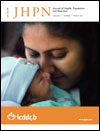Dietary Quality among Tehranian Adults in Relation to Lipid Profile: Findings from the Tehran Lipid and Glucose Study
DOI:
https://doi.org/10.3329/jhpn.v31i1.14747Keywords:
Diet quality index-international, Healthy eating index-2005, Lipid profile, Mediterranean diet scaleAbstract
The prevalence of dyslipidaemia has been increasing in developing countries that are undergoing nutrition transition. However, the association of diet quality and lipid profile has not been well-understood in these countries. The aim of the current study was to compare the ability of three diet quality indicesthe Mediterranean diet scale (MDS), healthy eating index-2005 (HEI-2005), and diet quality index-international (DQI-I) in relation to changes in lipid profile between baseline and 6.7 years of follow-up. Baseline data from two 24-hour dietary recalls provided by 469 adults with mean age of 38.7}12.3 years, who were participants of the Tehran Lipid and Glucose Study, were analyzed to describe dietary intakes. Data on anthropometry, sociodemography, physical activity, and other lifestyle variables were recorded, and a comparison of baseline and follow-up data revealed changes in the concentrations of total cholesterol (TC), triglyceride (TG), high-density lipoprotein cholesterol (HDL-C), and low-density lipoprotein cholesterol (LDL-C). A general linear model was used in assessing changes in lipid profile depending on adherence to diet quality indices at baseline, after adjustment for age, smoking status, waist-circumference, body mass index, physical activity, and energy intake. A significant interaction was observed between scores and sex, and upon stratification, males in the highest quartile score of the HEI-2005 had significantly lower TG changes than those in the lowest quartile, after adjusting for confounders (-8.8 vs 2.9, p=0.038). No association was apparent in females (-0.2 vs 11.2, p=0.297). In addition, a positive association was found between DQI-I and HDL-C (Q1=0.6 vs Q4=-2.0, p=0.044) in males. In both sexes, all these indices were weakly associated with TC while none was associated with LDL-C. It is concluded: adherence to the HEI-2005 recommendations was weakly associated with reduced TG concentration in an urban Iranian adult population. The MDS and DQI-I were not related to change in lipid profile.
J HEALTH POPUL NUTR 2013 Mar;31(1):37-48
Downloads
263
220

